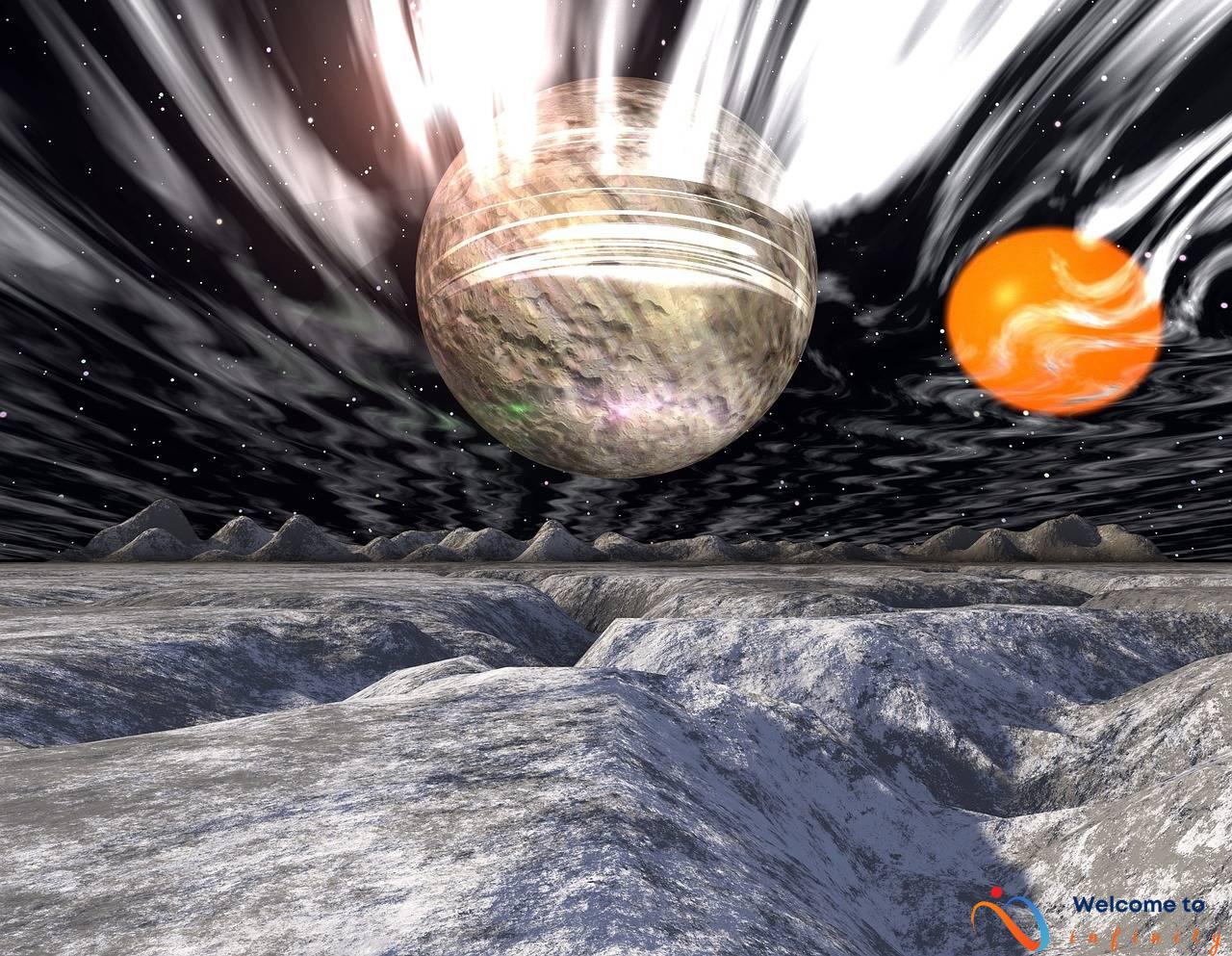Neptune, the eighth planet from the sun, is often referred to as the “mysterious planet.” The planet's blue color and quiet demeanor make it stand out among its neighboring planets. It was discovered in 1846, making it the first planet to be discovered through mathematical prediction. Despite being visible to the naked eye, Neptune remained a mystery for centuries.
One of the most fascinating aspects of Neptune is its dynamic atmosphere, which includes the fastest winds in the solar system. The planet's blue color is caused by the absorption of red light by its atmosphere, giving it a unique appearance. In addition to its distinctive characteristics, Neptune is also home to 14 known moons, with the largest being Triton.
- Triton – believed to be a captured Kuiper Belt object and one of the coldest places in the solar system
Neptune is also known for its rings, which are similar in appearance to Saturn's rings but are much fainter and narrower. They are believed to be made up of dust particles and the remnants of moons that were shattered by impacts.
Despite its intrigue, Neptune has only been explored by one spacecraft, the Voyager 2 mission in 1989. While there are proposed missions to explore Neptune, they are still in the planning stages and have not been approved.
Overall, Neptune continues to be a planet shrouded in mystery, but its unique characteristics make it a fascinating subject of study and exploration for astronomers and scientists alike.
The Discovery of Neptune
Neptune, the outermost planet of our solar system, remained a mystery until it was discovered in 1846. It would be surprising to know that it was visible to the naked eye from Earth, but none of the ancient astronomers could perceive it as a planet.
In the late 1700s, astronomers started to observe anomalies in Uranus's orbit, which could not be explained by the gravitational forces of other planets. These irregularities led French astronomer Alexis Bouvard to theorize the existence of an unseen eighth planet that was causing the perturbations.
John Couch Adams in England and Urbain Le Verrier in France independently calculated the position of the planet, and finally, Johann Gottfried Galle observed the planet during the same night as Le Verrier's calculations. Neptune became the first planet to be discovered through mathematical prediction, a significant achievement in the world of astronomy.
Upon its discovery, Neptune was named after the Roman god of the sea, and its position validated Le Verrier's mathematical prediction. The discovery of Neptune pushed astronomers to study the outer reaches of our solar system and proved that mathematics could predict the existence of celestial objects long before they are ever seen.
Characteristics of Neptune
Neptune is a gas giant and the eighth planet from the sun. It has a dynamic atmosphere that includes the fastest winds in the solar system. The winds on Neptune can reach speeds of up to 1,200 miles per hour, which is almost five times faster than the strongest winds ever recorded on Earth.
One of the most distinctive characteristics of Neptune is its blue color. This is caused by the absorption of red light by its atmosphere, which reflects mostly blue light. The atmosphere of Neptune is composed primarily of hydrogen and helium, with smaller amounts of methane and other gases.
Neptune is also known for its large storms that are visible in its atmosphere, including the Great Dark Spot that was discovered in 1989. This is believed to have been a giant storm system that lasted for several years before dissipating. The spot has since disappeared and been replaced by a smaller dark spot.
Neptune has a relatively small magnetic field compared to other planets in the solar system, but it is tilted at an angle of 47 degrees from its axis of rotation. The planet also has an unusual magnetic field that is highly tilted and offset from its center.
Despite being one of the largest planets in the solar system, Neptune has a low density that is slightly greater than that of water. If you were to place Neptune in a large enough pool of water, it would float.
The Moons of Neptune
=Neptune, the eighth planet in our solar system, has a total of 14 known moons, each varying in size and shape, with Triton being the largest among them. Triton is a strange and intriguing moon, believed to be a captured Kuiper Belt object. It is also one of the coldest places in the solar system, with surface temperatures that can drop as low as -235°C.
Triton orbits Neptune in the opposite direction to the planet's rotation, making it unique compared to other moons in the solar system. This means it moves from east to west while Neptune rotates from west to east. This peculiar movement has scientists puzzled, with various theories being proposed about how Triton ended up in its current position.
Triton is also known for its active surface, which is covered in nitrogen ice. Scientists have observed geysers of nitrogen gas being released from its surface, which may be caused by the warming effect of the sun on the ice. This has led scientists to believe that beneath the ice could be an ocean of liquid water, making Triton a possible location for extraterrestrial life.
Apart from Triton, other notable moons of Neptune include Nereid, the third-largest moon in the solar system, and Proteus, which is the second-largest and has a unique shape resembling that of a potato. The remaining moons are much smaller and have varied shapes and compositions.
Overall, the moons of Neptune are an important and fascinating area of study, providing valuable insights into the planet's history and composition. Further research and exploration of these moons could help us uncover more mysteries about our solar system and the universe beyond.
The Great Dark Spot
Neptune's giant dark spot, discovered in 1989 by NASA's Voyager 2 spacecraft, was one of the planet's most prominent features. The spot was similar to Jupiter's Great Red Spot, but in the case of Neptune, the spot was a dark, stormy area that measured roughly the size of Earth. It was located in Neptune's southern hemisphere and was believed to be a vortex of high-speed winds rotating around a central low-pressure system.
However, when the Hubble space Telescope observed Neptune in 1994, the Great Dark Spot was gone. The disappearance of the spot was a puzzling mystery for researchers. Later observations revealed a smaller dark spot that took its place, which was also located in the southern hemisphere and also may have been a vortex of high-speed winds. It is suspected that the formation and disappearance of these dark spots are connected to the unpredictable and dynamic weather patterns on Neptune.
Despite the disappearance of the Great Dark Spot, Neptune still boasts other fascinating features. With its dynamic atmosphere, unique blue color, and mysterious moons and rings, Neptune is truly a gem of our solar system. Although there are currently no future missions planned to explore Neptune, proposed missions such as the Trident and Ice Giants missions could shed more light on this enigmatic planet and its many mysteries.
Neptune's Rings
Neptune, the eighth planet from the sun, is known for having five rings. These rings are similar to the rings of Saturn, but they are much fainter and narrower in comparison. The rings of Neptune are very difficult to observe from earth because of their faint nature. In fact, they were only discovered in 1984 by the Voyager 2 spacecraft, which was the only spacecraft to visit Neptune as of now.
The rings of Neptune are believed to be made up of remnants of moons that were shattered by impacts and dust particles. The largest of Neptune's rings is called the Adams Ring, named after John Couch Adams. The other four rings are named after astronomers who have made significant contributions to the study of Neptune: Galle, Le Verrier, Lassell, and Arago.
Interestingly, three of Neptune's rings (Adams, Le Verrier, and Galle) are composed of narrow, relatively bright arcs. These arcs are believed to be maintained by the gravitational effects of nearby moons. The other two rings are diffuse in nature, meaning they are more spread out than the arcs and emit a fainter glow.
The microscopic particles that make up Neptune's rings reflect very little sunlight, which makes them difficult to observe. Scientists have studied the rings in detail using the Voyager 2 spacecraft and have found them to be composed largely of water ice. The rings of Neptune continue to be a subject of scientific inquiry, and it is hoped that future missions will provide more insights into their composition and origin.
Exploration of Neptune
Neptune is one of the least explored planets in our solar system. Only one spacecraft, the Voyager 2, has visited the planet so far. The Voyager 2 mission took place in 1989 and provided us with valuable insights into the planet and its moons. During the mission, Voyager 2 flew by the planet at a distance of 4,950 kilometers, providing close-up images of the planet's atmosphere, rings, and moons.
The mission discovered that Neptune's atmosphere is very dynamic and has the fastest winds in the solar system, reaching up to 2,100 kilometers per hour. The spacecraft also identified a giant dark spot in the southern hemisphere of the planet, which has since disappeared and been replaced by a smaller dark spot.
Despite the success of the Voyager 2 mission, there are currently no plans for any future missions to Neptune. However, there are some proposed missions in the planning stages, including the Trident mission and the Ice Giants mission. The Trident mission would send a spacecraft to explore Neptune's largest moon, Triton, while the Ice Giants mission would study both Neptune and Uranus. These missions remain in the planning stages and have yet to be approved.
Possible Future Missions
In an effort to learn more about Neptune and its moons, several proposed missions have been suggested. One of these is the Trident mission, which would be a flyby mission designed to explore Neptune's largest moon, Triton. Triton is believed to be a captured Kuiper Belt object, and studying it could provide valuable insights into the early formation of the solar system.
Another proposed mission is the Ice Giants mission which would study both Neptune and Uranus. The mission would likely involve launching a spacecraft equipped with a suite of instruments, including cameras, spectrometers, and magnetometers. The mission is currently in the planning stages, and it is unclear when or if it will be approved.
It is important to note that proposed missions to Neptune are still in the planning stages, and nothing has been confirmed yet. The cost and technical challenges of sending a spacecraft to Neptune make it a difficult mission to undertake. However, if such a mission were to be successful, it would provide groundbreaking insights into one of the most mysterious planets in our solar system.










